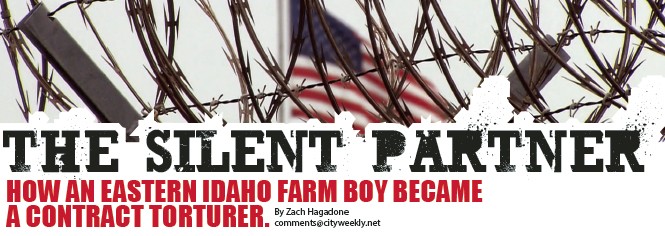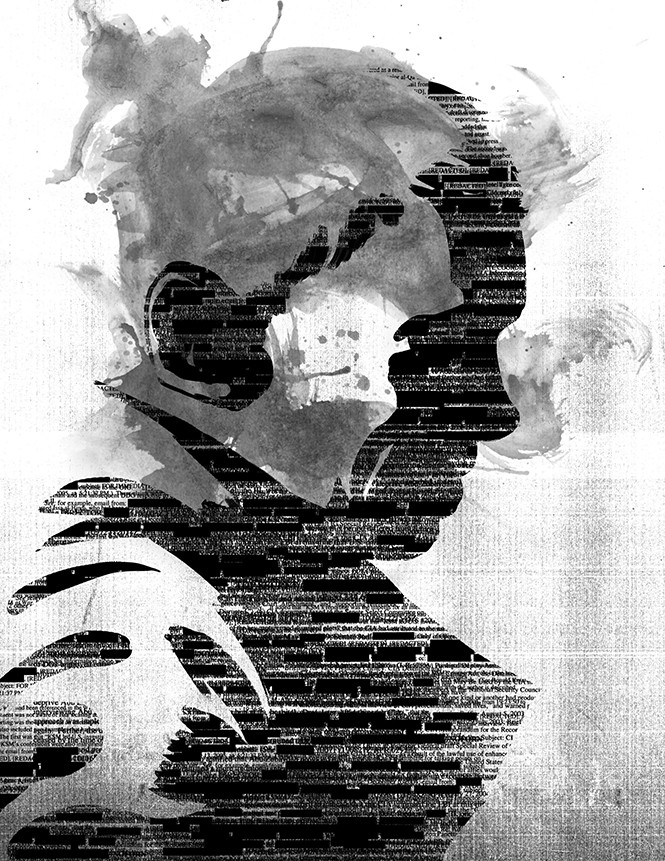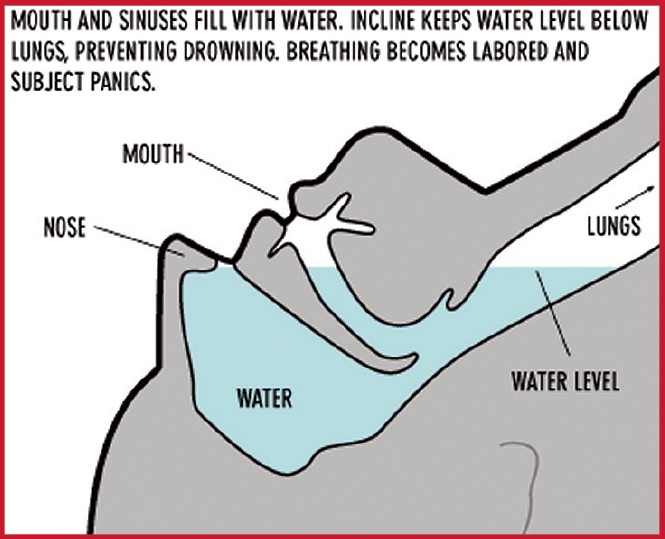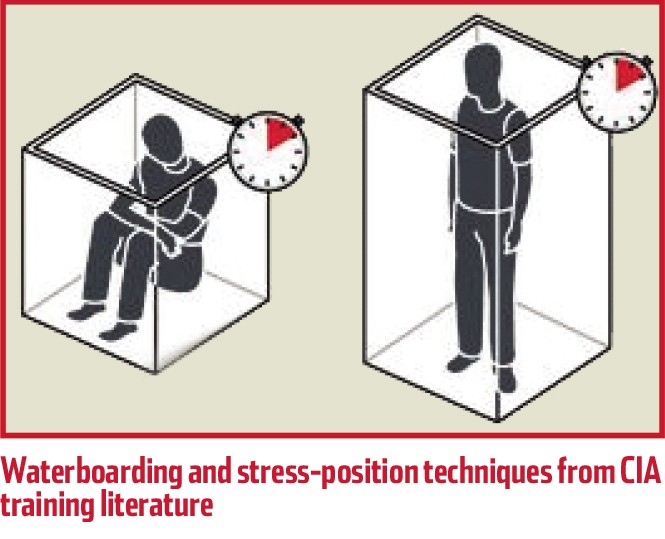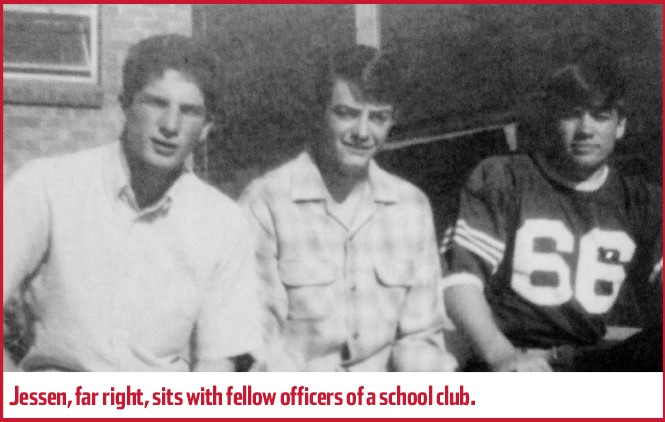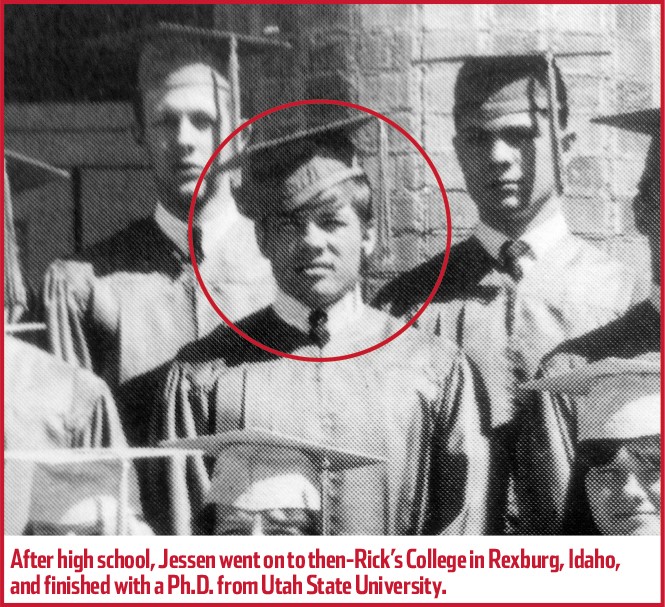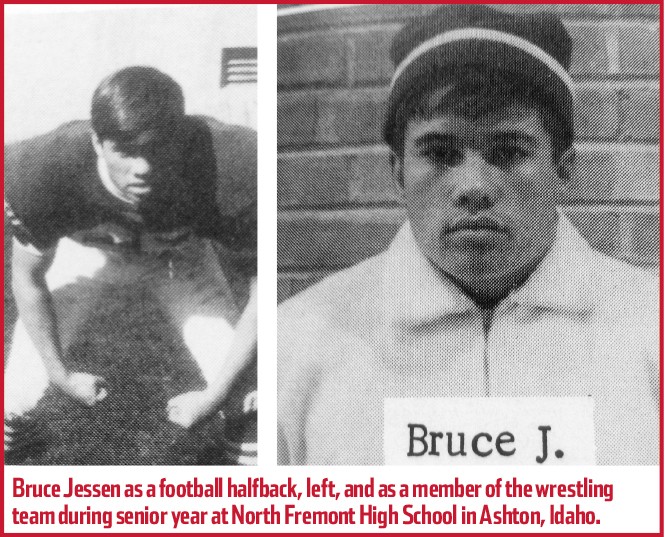Bruce Jessen has been called a war criminal. A torturer. An "American Mengele." The retired Air Force colonel and trained psychologist was, according to a 2014 report from the U.S. Senate Select Committee on Intelligence, an architect of the "brutal," "inherently unsustainable" and "deeply flawed" detainee- interrogation program that "damaged the United States' standing in the world" in the years following the attacks of Sept. 11, 2001.
His alleged actions involved helping design—and in many cases personally administer—methods of interrogation that groups ranging from the American Civil Liberties Union to Amnesty International and the United Nations have labeled as torture.
Those methods, according to the report, were applied in secret throughout the Central Intelligence Agency's now infamous network of "black sites" where detainees were held without charges in "dungeon"-like conditions.
Jessen did not act alone. Fellow retired Air Force officer and psychologist James Mitchell helped design, advise, apply and assess the program—operating in a system with almost no checks and which the CIA's own attorneys admitted would require a "novel" legal defense "to avoid prosecution of U.S. officials who tortured to obtain information."
While Mitchell has publicly pushed back against the report, calling it "bullshit" in a December 2014 interview with ABC News, Jessen has avoided speaking to the media—the silent partner in a global scandal.
The contents of the almost 600 pages of the Senate report are as harrowing as they are detailed, except when it comes to the backgrounds of Jessen and Mitchell, referred to by the pseudonyms of Drs. Dunbar and Swigert, respectively.
Their true names weren't known until a 2007 Vanity Fair report, which presaged much of what would come to light in the 2014 Senate report. Eight years later, as HBO has optioned the rights for an original film based on the article, "Rorschach and Awe," Mitchell is less mysterious but Jessen remains an enigma.
His road to the secret prisons of Afghanistan, Thailand and Poland, however, began in eastern Idaho—literally, on Highway 20, in a small town at the foot of the Teton Mountains.
'Not Much of a Talker'
As Highway 20 runs north from Idaho Falls, the suburbs give way to run-down trackside buildings. Trash-strewn ditches and fields of cattle are interrupted by lonely monochromatic housing developments. Billboards alternately advertise Internet service and professional-technical degrees, and protest against wind power and same-sex marriage.
The road narrows north of St. Anthony, with the Henry's Fork of the Snake River running to the west and the Tetons rising hazy-blue on the eastern horizon. A few miles farther, at the gateway to the Caribou-Targhee National Forest and West Yellowstone, Mont., is the town of Ashton—set in a wide, flat valley punctuated by a cluster of grain silos.
Main Street in Ashton is a collection of mom & pop shops—an auto-parts store, hardware store, liquor store, senior-recreation center, two bars and three churches. Trucks rumble by almost constantly, carrying grain and seed potatoes to the silos that dominate the west side of town. Glance down the side streets from Main and the residential neighborhoods quickly give way to fields.
Springtime is blustery and cold, and potatoes are more plentiful than people.
"It's time to plant the silly things again," said Barbara Moon, who works part-time as Ashton's town archivist. "It used to take the whole town [to plant and harvest], but not anymore."
The Jessens were a potato family. Jessen's father, Jack, worked their land south of town.
"He was a wonderful man, but not much of a talker," Moon said. It was Nieca, Jessen's mother, who was the family's social link.
"She loved people, loved talking to them," Moon said.
Bruce, meanwhile, was quiet, like his father.
"To say I know him—no, I really didn't," Moon said, navigating the stacks of yearbooks, family histories and mountains of newspaper clippings in the small archive office located in the Ashton Chamber of Commerce building.
"I went to a party once [at the Jessen farm] and talked with him and his wife and met his children, but that was it," she said.
Asked if she had heard of the Senate report or read any coverage of its revelations about Jessen's work with the CIA, she said she had not.
"I didn't even know about that," Moon said, though added that she was aware Jessen worked for the government in some capacity in Spokane, Wash.
Moon has lived in Ashton for 50 years—long enough to know just about everyone in town but, because she wasn't born there, she gets teased occasionally that she's not a native.
"Like all small towns, it has its good sides and its bad sides, but it's a wonderful place to raise a family," she said.
Jessen's family goes back a long way in the Ashton area. His mother was born in nearby Marysville to the Cordingley family, whose members to this day are "everywhere," Moon said.
"You have to be careful what you say around here, because everybody knows everybody," she said.
Of Jessen, Moon could only repeat that she didn't know him well, though she did add that one of his two sisters is among her best friends.
"What little I knew of him, I thought he was nice," Moon said. "And quiet is right. Very intelligent."
According to Moon, the Jessens were a tight-knit family, and Bruce was especially close with his adopted brother, who recently passed away. The Jessens took in the boy when he was about 8 years old. He and Bruce were close in age, graduating from high school in the same class.
Inviting another child into her family was in line with Nieca's personality, Moon said.
"Nieca was that kind of person," she said, adding that each spring the matriarch would host a party for the senior high-school girls "just because she wanted to." Another yearly party would be thrown for Sunday school teenagers.
"Everybody in the town was there," Moon said. "Everybody loved her in town."
For Bruce, active in high-school sports, intelligent and good-looking, Ashton probably started to feel too small.
"He had to work; dig potatoes and plow—I know he did that," Moon said. "No wonder he wanted to go do something else."
'Something Not Previously Seen'
In August 2002, Jessen was a long way from Ashton. By that time, he and Mitchell had secured a contract with the CIA that would come to be worth upward of $180 million by 2006. Their job was to travel through the agency's prison system to help coordinate the application of "enhanced interrogation techniques" that they developed based on their work as former training experts in the SERE program—short for Survive, Evade, Resist, Escape. Intended to train U.S. military personnel how to withstand harsh interrogation at the hands of unscrupulous enemies, Jessen and Mitchell had reportedly "reverse-engineered" the techniques to craft what has been referred to as the U.S. "torture program."
At a CIA black site in 2002, which was later reported to be located in northeast Poland, Jessen and Mitchell were preparing for the biggest test of their methods yet. Abu Zubaydah had been captured in Pakistan in March 2002 and was being held on suspicion of running an al Qaeda site there. When enhanced techniques—including the now well-known practice of simulated drowning called waterboarding—were approved for use on Zubaydah, only Jessen and Mitchell were to have contact with him.
Based on the psychologists' plan, Zubaydah was subjected to enhanced interrogation techniques on a "near 24-hour-per-day basis" for 17 straight days, according to the Senate report. He was shackled, hooded and stripped on the first day of interrogations, as an interrogator slammed him against a wall. He was unhooded and made to watch as interrogators brought in a large "confinement box" that was placed in his cell to mimic a coffin. If Zubaydah did not offer the asked-for information, he was slapped or grabbed by the face.
He maintained that he did not have any additional information, and Jessen and Mitchell were not authorized by CIA leadership to ask any questions other than to demand Zubaydah's knowledge of plans to attack the United States.
The enhanced techniques were continued, with Zubaydah being waterboarded two to four times per day for more than two weeks in what the report called the "aggressive phase of interrogation." During a total of 20 days, Zubaydah spent 11 days in the coffin-size confinement box and 29 hours in a smaller box, which measured 21 inches wide, 2.5 feet deep and 2.5 feet high. According to the report, Zubaydah was told that the only way he would leave the facility was in the coffin-shaped box.
When concerns reached CIA Headquarters that the interrogation was "approach[ing] the legal limit," Counterterrorism Center Chief Jose Rodriguez responded by telling CIA officers not to question the legality of their activities in written communications. "Such language is not helpful," he wrote.
According to the Senate report, several members of the agency exposed to—or involved in—the tactics expressed "reservations about being engaged in the interrogations."
Emails excerpted in the report, dated August 2002, show a deep unease about viewing the interrogations—both in person and on video:
"It is visually and psychologically very uncomfortable."
"It seems the collective opinion that we should not go much further."
"Several on the team [were] profoundly affected ... some to the point of tears and choking up."
"[Video footage] has produced strong feelings of futility (and legality) of escalating or even maintaining the pressure. ... Prepare for something not previously seen."
Reporting from the detention sites became sparse—enough so that the CIA general counsel was concerned that, without more frequent and detailed reports, "the agency cannot monitor the situation."
The situation was, according to some, running off the rails.
According to the report, at least five detainees were subjected to having liquids—whether water or pureed food—injected into their rectums, including Zubaydah. At least once he was also the subject of an "unexpected rectal exam" as part of the detention site's security protocols.
At the end of his August 2002 interrogation, Zubaydah was found to have been telling the truth that he had no new threat information. Meanwhile, he had lost an eye at some point during his detention and several video recordings of his interrogation were destroyed. He was waterboarded 83 times.
Despite the CIA's belief that he was the "third or fourth" highest ranking al Qaeda, Zubaydah turned out to be a low-level administrator. What little information he provided came in the two months before Jessen and Mitchell arrived with their techniques. Zubaydah is currently imprisoned in Guantanamo Bay, Cuba—a prisoner held without charges for more than 12 years.
Jessen and Mitchell wrote in a cable that the interrogation was a success, with the "aggressive phase" of the questioning recommended as a "template for future interrogation of high value captives." Their reasoning was not that the tactics produced useful information, but that they confirmed what Zubaydah didn't know.
"Our goal was to reach the stage where we have broken any will or ability of subject to resist or deny providing us information (intelligence) to which we had access," Jessen and Mitchell wrote. "We additionally sought to bring subject to the point that we confidently assess that he does not/not [sic] possess undisclosed threat information, or intelligence that could prevent a terrorist event."
'It is No Wonder They Settled Here'
In mid-April, snow still lay in the playground next door to the Zion Lutheran Church in Ashton. Across the street is the Ashton Library, which, along with North Fremont High School and the Church of Jesus Christ of Latter-day Saints ward house a few hundred yards down Main Street, is the nicest building in town.
Among the volumes of local history is a two-volume collection titled Ashton Family Histories, 1906-2006, and a stack of North Fremont High School yearbooks. Between those sources, a basic picture of the Jessen family begins to take shape.
The Jessens take up 11 pages in Ashton Family Histories, not counting extended relations. When asked about the family, the librarians were quick to name several members, including Jessen's sisters. When the subject of Bruce Jessen came up, they, like Moon, said they didn't know him well.
John "Bruce" Jessen was born July 28, 1949, in St. Anthony, Idaho, the youngest of three children in the family of John "Jack" Jessen and Nieca Cordingley Jessen. He grew up in Ashton, where, according to an entry in Family Histories, his family could trace a "history of early settlement" and count "six generations of childhood."
Aside from working as a farmer, father Jack was a member of the volunteer fire department and served on the Potato Board. Nieca worked at a variety store in Ashton, was assistant manager of an irrigation company, served as president of the local LDS relief society and taught Sunday school. She volunteered with the Ashton Chamber of Commerce and served a term as its president. Both Jack and Nieca served in the Idaho Falls LDS Temple for 23 years.
Jessen spent his childhood on a century-plus-year-old homestead that the family bought 2 1/2 miles southwest of Ashton on Highway 20.
Affectionately called "the farm" by family and friends alike, the Jessens raised their children in an idyllic rural setting. Photos in Ashton Family Histories show a rolling lawn and orchards.
Nieca described her home as "this beautiful little valley in Ashton, Idaho. To the East lies the majestic Teton Mountains. To the North the Snake River, and the beautiful forest with pines, aspen and mountain ash trees. To the West, the rolling sand hills, and the South, on to the big city. It is no wonder they settled here in this little valley in the 1800s."
In the 1980s, the Jessens sold the farm and turned it into an R.V. park and bed & breakfast, which became a family gathering place and stopping point for tourists on their way to Yellowstone and the ski resorts of western Wyoming. Nieca ran the park until her death in 2013, and it is now operated under a new name by new owners, though a roadside sign still bears the name "Jessen's R.V. Park."
Jessen graduated from North Fremont High School in 1967, where he was involved in a range of activities, including ski club, band, assemblies, Boys State, baseball, football, basketball, track and wrestling.
Photographs in his senior yearbook show a handsome, athletic kid.
After high school Jessen attended then-Ricks College, now Brigham Young University-Idaho, a few miles down the road from Ashton in Rexburg, going on to graduate cum laude from Utah State University in 1974, where he majored in psychology with a minor in aerospace studies and Italian. He went on to earn his doctorate in psychology, with an emphasis in professional-scientific psychology, from USU in 1979.
During that time he was enlisted in the Air Force and completed an internship in clinical psychology at Wilford Hall Medical Center in San Antonio, Texas.
Jessen's doctoral thesis was titled "The Effect of Family Sculpting on Perceptual Agreement Among Family Members" and focused on a technique for family therapy.
Of the six USU faculty members who advised Jessen on his dissertation, only two are still living. Asked if she remembered Jessen as a student, Dr. Jean Pugmire, who still lives in Logan, Utah, said, "No, I really don't."
"I think you'll find that most of the people that would have been involved with him are dead," she said. "I'm sorry, but I don't remember him at all."
'The Agency Erred'
Only one detainee is known to have died while in custody at any of the CIA's secret prisons, and he died shortly after being interrogated by Jessen.
Gul Rahman was an Afghani arrested by U.S. agents and Pakistani forces during an attack inside Pakistan. His capture took place on Oct. 29, 2002. Less than a month later he was found dead at the notorious "Salt Pit" detention site in Kabul, Afghanistan—stripped from the waist down and shackled to a wall in such a way that he would be forced to sit on the concrete floor in freezing conditions.
Jessen personally interrogated Rahman days before he was found dead, on Nov. 20, 2002, using methods that were not authorized, according to the Senate report. Jessen had traveled to the Salt Pit at the request of the CIA's ALEC Station—which was tasked with locating Osama bin Laden—where he determined the types of interrogation techniques that should be used on Rahman.
According to the report, those techniques included the "insult" slap, auditory overload, total darkness, isolation, cold showers, 48 hours of sleep deprivation and "hard" or "rough" takedowns, which included being dragged outside where his clothes were cut off. Restrained with Mylar tape and wearing a hood, Rahman would be forced to run up and down a long hallway, with CIA personnel slapping and punching him along the way.
Jessen reportedly told CIA officials during an investigation into Rahman's death that "although it was obvious [the CIA officers] were not trying to hit him as hard as they could, a couple of times the punches were forceful. As they ran him along the corridor, a couple of times he fell and they dragged him through the dirt. ... Rahman did acquire a number of abrasions on his face, legs and hands, but nothing that required medical attention."
When Rahman's body was discovered, he was found to have abrasions on his shoulder, pelvis, arms, legs and face. A CIA autopsy report said his cause of death was "undetermined," but the Senate report notes that the "clinical impression" of the medical officer who performed the autopsy was that Rahman died of hypothermia.
His death ushered in a phase of increased scrutiny of the detention and interrogation activities from CIA headquarters, but, the report notes that many of those involved with Rahman's interrogation "remained key figures in the CIA."
In 2005, Jessen and Mitchell established their firm—Mitchell, Jessen & Associates—in Spokane, which from 2005-2009 was paid $81 million for its services. Prior to 2005, the pair was being paid a reported $1,800 per day.
In 2013—more than a decade after Rahman's death—the CIA issued a response to the Senate Select Committee on Intelligence as part of a report on the rendition, detention and interrogation program:
"We acknowledge that the Agency erred in permitting the contractors [Jessen and Mitchell] to assess the effectiveness of enhanced techniques. They should not have been considered for such a role given their financial interest in continued contracts from CIA."
'Uncharted Territory'
With a freshly minted doctorate from Utah State University, Jessen went to work in the SERE program, helping train airmen to "survive, evade, resist and escape" the interrogation methods used by Cold War-era Communist countries and enemies who could not be expected to abide by the Geneva Conventions. By 1980—around the time Jessen was working as an operational psychologist with the Air Force—SERE curriculum had become standardized across all the branches of the military.
It is brutal training. Over a multi-week series of sessions, soldiers are taught the academics of survival and evasion skills, then taken into the field to learn practical survival techniques. The final phase of the program includes setting trainees loose in the field to evade searchers. Once captured, they are imprisoned in a mock POW camp and subjected to even harsher conditions, including verbal abuse, sexual humiliation, painful stress positions and, in some cases, waterboarding.
Jessen was stationed primarily at Fairchild Air Force Base in Spokane, Wash., where he and Mitchell were colleagues. According to the Senate report, the pair would go on to develop "theories of interrogation based on 'learned helplessness,'" drawn from their experiences with SERE.
"Neither psychologist had any experience as an interrogator, nor did either have specialized knowledge of al-Qa'ida, a background in counterterrorism, or any relevant cultural or linguistic expertise," the report noted.
Jessen's résumé, submitted to the CIA in 2003, contained redacted examples of his role as a "debriefer" as well as details of a one-week defense interrogation course in 2002. He and Mitchell had drafted academic and research papers on various psychological aspects of interrogation as they related to the Air Force's SERE program, "all of which were relevant to the development of the program," according to a 2013 response to the investigation by the CIA.
"Drs. [Mitchell] and [Jessen] had the closest proximate expertise CIA sought at the beginning of the program, specifically in the area of non-standard means of interrogation," the CIA wrote. "We believe their expertise was so unique that we would have been derelict had we not sought them out when it became clear that CIA would be heading into the uncharted territory of the program [italics and emphasis in original]."
In his first on-camera interview, which Vice News posted to You Tube on Dec. 10, 2014, Mitchell called the idea that he and Jessen "reverse-engineered" SERE into a torture program a "myth" but, citing a nondisclosure agreement, wouldn't go into detail on the origins of the program, his role in it or even whether he was the psychologist referred to in the Senate report as "Dr. Swigert."
Meanwhile, he told The New York Times in December 2014 that he was "just a cog in the machine."
In the Vice interview, Mitchell mentioned Jessen by name, referring to their work together in the SERE school and describing the thrust behind enhanced interrogation techniques.
"It's almost like a good cop/bad cop kid of set up, you know, with a really bad cop," he said. "It was to facilitate getting actionable intelligence by making a bad cop that was bad enough that the person would engage with the good cop."
While Mitchell has been public with his attacks on the Senate report, Jessen has kept a low profile, refusing to speak with reporters other than to repeat, as he did to Reuters news service that "it's a difficult position to be in. You want to set the record straight."
A call to Jessen's Spokane phone number went unanswered, but, in the days after the release of the Senate report, staff writer Jacob Jones, of the Spokane-based Pacific Northwest Inlander, confronted Jessen outside his $1.2 million home south of Spokane.
"There's a lot going on," he told Jones. "It's a difficult position to be in."
Jessen wouldn't go into detail about the contents of the report, also citing a nondisclosure agreement, but told Jones that media reports had contained "distortions." He noted a "No Trespassing" sign and told the reporter, "You know, they didn't prosecute Zimmerman."
"In hindsight, this seems like a clear reference to the legality of deadly force in so-called 'stand your ground' situations," Jacobs wrote. "So that's where his mind went."
'Where His Mind Went'
"This is a train wreak [sic] waiting to happen and I intend to get the hell off the train before it happens."
Those words were written by the CIA's chief of interrogations in a 2003 email to colleagues, announcing he would be "retiring shortly," before Jessen could reportedly renew interrogation of Abd al-Rahim al-Nashiri, one of the alleged plotters in the bombing of the U.S.S. Cole and East African U.S. Embassy in 1998.
By then, al-Nashiri had been in U.S. custody for about a year, bounced from CIA black site Cobalt in Afghanistan to Detention Site Green and, finally, Detention Site Blue—secret facilities later identified as being located in Kabul; Udon Thani, Thailand; and Szymany, Poland, respectively.
In Thailand and Poland, al-Nashiri had been waterboarded and was judged "compliant" by interrogators. Regardless, according to records cited in the report, CIA Headquarters pushed for continued use of enhanced techniques despite a recommendation that they be discontinued.
"[The] bottom line is that we think [al-Nashiri] is being cooperative, and if subjected to indiscriminate and prolonged enhanced measures, there is a good chance he will either fold up and cease cooperation, or suffer the sort of permanent mental harm prohibited by the statute," interrogators wrote in a cable from the detention site.
A CIA officer was dispatched to administer enhanced interrogation, which included stress positions, blindfolding, and threats with an air pistol and cordless drill. At one point he was reportedly told that his mother would be brought to the site and sexually abused.
In January 2003, about three months into al-Nashiri's interrogation, Jessen was called to assess whether the detainee could withstand any more interrogation and, if so, give recommendations on what techniques should be used.
Jessen's opinion was that interrogators should have the "latitude to use the full range of enhanced exploitation and interrogation measures."
To CIA headquarters, the chief of interrogators wrote a cable intended to be shared among officers at Detention Site Blue—however, according to the Senate report, it does not appear to have been disseminated.
"[W]e have serious reservations with the continued use of enhanced techniques with [al-Nashiri] and its long term impact on him," he wrote, adding that "continued enhanced methods may push [al-Nashiri] over the edge psychologically."
The chief of interrogations was concerned about Jessen's role specifically: Not only was he administering the interrogation, but assessing its success. "The role of the ops psychologist is to be a detached observer and serve as a check on the interrogator to prevent the interrogator from any unintentional excess of pressure which might cause permanent psychological harm to the subject," the chief interrogator wrote. "Therefore, the medical officer and the psychologist should not serve as an interrogator, which is a conflict of responsibility. We note that [the proposed plan] contains a psychological interrogation assessment by [redacted] psychologist [Jessen] which is to be carried out by interrogator [Jessen]. We have a problem with him conducting both roles simultaneously."
CIA headquarters ignored the chief interrogators' cable and went forward with Jessen's plan for al-Nashiri.
Between June 2003 and September 2006, al-Nashiri was moved to five different CIA sites around the world and diagnosed by some CIA psychologists with anxiety and major depressive disorder.
In 2004 Jessen and another interrogator wrote in a report that al-Nashiri had given "essentially no actionable information."
Al-Nashiri is currently on trial before a military tribunal in Guantanamo on charges that carry the death penalty.
'No Comment'
Along with finding that the psychologists helped inflict "immeasurable damage to the United States' public standing, as well as to the United States' longstanding global leadership on human rights in general and the prevention of torture in particular," the Senate report called into question the fruits of their interrogations. The CIA "never conducted a credible, comprehensive analysis of the effectiveness" of the enhanced techniques, the report stated. What's more, almost no one involved in the interrogations was ever "held accountable or removed from positions of responsibility," despite "significant violations, inappropriate activities, and systematic and individual management failures."
Dating back at least to 2009, with the release of memos detailing the interrogation program, The American Psychological Association has repeatedly issued statements condemning both Jessen and Mitchell, though neither are members of the organization and the APA's own role in facilitating the establishment of enhanced interrogation methods has been called into question.
"If the allegations are true, what this pair did was pervert psychological science to break down and dehumanize detainees in a misguided effort to extract information. It is clear to me that their actions constituted torture," 2014 APA President Nadine Kaslow wrote in a statement issued Dec. 23, 2014.
As recently as Feb. 18, 2015, Jessen held a current, though inactive, license to practice psychology in Idaho. Though not due to expire until July 28, 2015, a check of the Idaho Bureau of Occupational Licenses in early April showed that his licensure—formerly PSY-195—had disappeared. It is still unclear on what grounds Jessen is no longer licensed in the state.
"I do not have any other information regarding Dr. Jessen other than he is not currently licensed under the Board of Psychological Examiners, therefore he will not appear on our website," Bureau of Occupational Licenses Management Assistant Cherie Simpson wrote in an email.
According to Idaho Statute, a psychologist's license may be "revoked, suspended, restricted or otherwise disciplined" if the holder is "[f]ound by the board to have been unethical as detailed by the current, and future amended, ethical standards of the American Psychological Association."
Jessen was appointed in 2012 to serve as bishop of an LDS congregation in Spokane, but resigned shortly thereafter amid protests from human rights groups.
At the time, Spokane Stake President James Lee, who proposed Jessen for the office, stood by him.
"He'll take a beating in the press before he sets the record straight," he told The Spokesman-Review, which has routinely reported on Jessen since his identity was revealed. "The whole story has not been told."
Meanwhile, calls for accountability have come from around the world, including Amnesty International, which advocated in December 2014 for "a full investigation, prosecution and remedy for victims," and the United Nations.
"It is now time to take action," stated Ben Emmerson, U.N. special rapporteur on counter-terrorism and human rights, in a statement issued in Geneva following release of the Senate report. "The individuals responsible for the criminal conspiracy revealed in today's report must be brought to justice, and must face criminal penalties commensurate with the gravity of their crimes."
The U.S. Justice Department has already said it does not plan to pursue charges against those named in the report, which notes that pre-emptive protections from legal fallout came as early as 2002, when the CIA drafted a letter to then-Attorney General John Ashcroft asking the DOJ for "a formal declination of prosecution, in advance, for any employees of the United States, as well as any other personnel acting on behalf of the United States, who may employ methods in the interrogation of Abu Zubaydah that otherwise might subject those individuals to prosecution." The report mentions that there are no records indicating whether the letter was ever actually sent to the attorney general.
Asked if it had a stance on the APA's statements regarding the allegations against Jessen, the Idaho Psychological Association drew a blank. "We haven't been involved in any of that, and his name does not ring a bell for me," said IPA Executive Director Deborah Katz.
That appears to be the case with Bruce Jessen, generally: referred to as "Dr. Dunbar" in the Senate report, holder of a vanished Idaho psychology license, living quietly in a rural mansion in eastern Washington and part of a small-town family that everyone—from the local librarians to the city archivist—seems to know, except for him.
Asked to respond to the report and give some insight into their brother, one of Jessen's sisters did not respond. The other, reached by phone at her home, was quick to answer:
"I have no comment." CW
This story was originally published in the Boise Weekly.
More by Zach Hagadone
-
The Silent Partner
How an eastern Idaho farm boy became a contract torturer
- Jun 17, 2015
- More »
Latest in Cover Story
Readers also liked…
-
Forget the family pedigree—Robert F. Kennedy Jr should not be the next president of the United States
Trojan Horse
- Jun 21, 2023
-
Women decry harassment and toxic culture at St. George auto dealership
Men at Work
- Oct 11, 2023


